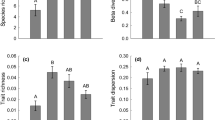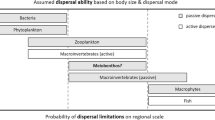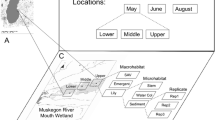Abstract
In nature, very few species are common and broadly distributed. Most species are rare and occupy few sites; this pattern is ubiquitous across habitats and taxa. In spatially structured communities (metacommunities), regional distribution and local abundance may change as the relative effects of within-habitat processes (e.g., species interactions) and among-habitat processes (e.g., dispersal) may vary through succession. A field experiment with the marine benthic inhabitants of pen shells (Atrina rigida) tested how common and rare species respond to succession and metacommunity size. I followed community development through time and partitioned species into sessile and motile based on their natural history. Rare species drive diversity patterns and are influenced by metacommunity size: there are strong abundance–distribution differences between common and rare species in large metacommunities, but motile species show lower rates of change than sessile species. In small metacommunities both common and rare species have similar changes through time; the dichotomous distinction of common and rare species is not present. Edge effects in metacommunities affect species’ changes in distribution and abundance. In large metacommunities diversity is higher in edge habitats relative to small metacommunities during early succession. However, edge effects benefit motile species over time in small metacommunities showing a rapid increase in diversity. Individual mobility is sensitive to regional community size and allows individuals to sort among different communities. In contrast, sessile species do not show this edge effect. Metacommunity theory is a useful framework for understanding spatially structured communities, but the natural history of coexisting species cannot be ignored.





Similar content being viewed by others
References
Amarasekare P (2003) Competitive coexistence in spatially structured environments: a synthesis. Ecol Lett 6:1109–1122
Brown JH (1984) On the relationship between abundance and distribution of species. Am Nat 124:255–279
Brown JH, Kodricbrown A (1977) Turnover rates in insular biogeography: effect of immigration on extinction. Ecology 58:445–449
Bruno JF, Stachowicz JJ, Bertness MD (2003) Inclusion of facilitation into ecological theory. Trends Ecol Evol 18:119–125
Caswell H (1976) Community structure: a neutral model analysis. Ecol Monogr 46:327–354
Chase JM, Leibold MA (2003) Ecological niches. University of Chicago Press, Chicago
Chave J (2004) Neutral theory and community ecology. Ecol Lett 7:241–253
Chesson P (2000) Mechanisms of maintenance of species diversity. Annu Rev Ecol Syst 31:343–366
Connell JH, Slatyer RO (1977) Mechanisms of succession in natural communities and their role in community stability and organization. Am Nat 111:1119–1144
Cornell HV, Lawton JH (1992) Species interactions, local and regional processes, and limits to richness of ecological communities: a theoretical perspective. J Anim Ecol 61:1–12
Freckleton RP, Noble D, Webb TJ (2006) Distributions of habitat suitability and the abundance–occupancy relationship. Am Nat 167:260–275
Gaston KJ, Blackburn TM (1999) A critique for macroecology. Oikos 84:353–368
Gaston KJ, Blackburn TM, Lawton JH (1997) Interspecific abundance-range size relationships: an appraisal of mechanisms. J Anim Ecol 66:579–601
Gaston KJ, Blackburn TM, Greenwood JJD, Gregory RD, Quinn RM, Lawton JH (2000) Abundance–occupancy relationships. J Appl Ecol 37:39–59
Gonzalez A, Lawton JH, Gilbert FS, Blackburn TM, Evans-Freke I (1998) Metapopulation dynamics, abundance, and distribution in a microecosystem. Science 281:2045–2047
Guichard F, Steenweg R (2008) Intrinsic and extrinsic causes of spatial variability across scales in a metacommunity. J Theor Biol 250:113–124
Hanski I (1982) Dynamics of regional distribution—the core and satellite species hypothesis. Oikos 38:210–221
Holyoak M, Leibold MA, Holt RD (eds) (2005) Metacommunities. Spatial dynamics and ecological communities. University of Chicago Press, Chicago
Hubbell SP (2001) The unified neutral theory of biodiversity and biogeography. Princeton University Press, Princeton
Krebs CJ (1999) Ecological Methodology, 2nd edn. Addison-Welsey Educational Publishers, Menlo Park
Leibold MA et al (2004) The metacommunity concept: a framework for multi-scale community ecology. Ecol Lett 7:601–613
Levins R, Culver D (1971) Regional coexistence of species and competition between rare species. Proc Natl Acad Sci 68:1246–1248
Livingston G, Philpott S (2010) A metacommunity approach to co-occurrence patterns and the core-satellite hypothesis in a community of tropical arboreal ants. Ecol Res 25:1129–1140
MacArthur RH (1972) Geographical ecology. Princeton University Press, Princeton
Magurran AE, Henderson PA (2003) Explaining the excess of rare species in natural species abundance distributions. Nature 422:714–716
Mouquet N, Loreau M (2002) Coexistence in metacommunities: the regional similarity hypothesis. Am Nat 159:420–426
Mouquet N, Loreau M (2003) Community patterns in source-sink metacommunities. Am Nat 162:544–557
Mouquet N, Munguia P, Kneitel JM, Miller TE (2003) Community assembly time and the relationship between local and regional species richness. Oikos 103:618–623
Munguia P (2004) Successional patterns on pen shell communities at local and regional scales. J Anim Ecol 73:64–74
Munguia P (2006) Diversity patterns of pen shell (Atrina rigida) communities. Department of Biological Science, Florida State University, Tallahassee, FL
Munguia P (2007) Spatial structure of communities on dead pen shells (Atrina rigida) in sea grass beds. Mar Biol 152:149–156
Munguia P, Miller T (2008) Habitat destruction and metacommunity size in pen shell communities. J Anim Ecol 77:1175–1182
Munguia P, Mackie C, Levitan DR (2007) The influence of stage-dependent dispersal on the population dynamics of three amphipod species. Oecologia 153:533–541
Munguia P, Osman RW, Hamilton J, Whitlatch R, Zajac R (2011) Changes in habitat heterogeneity alter marine sessile benthic communities. Ecol Appl 21:925–935
Nee S, Gregory RD, May RM (1991) Core and satellite species: theory and artifacts. Oikos 62:83–87
Ostman O (2011) Abundance–occupancy relationships in metapopulations: examples of rock pool Daphnia. Oecologia 165:687–697
Pandit SN, Kolasa J, Cottenie K (2009) Contrasts between habitat generalists and specialists: an empirical extension to the basic metacommunity framework. Ecology 90:2253–2262
Preston FW (1962) The canonical distribution of commonness and rarity. Part II. Ecology 43:410–432
Rabinowitz D (1981) Seven routes to rarity. In: Synge H (ed) The biology of rare plant conservation. Wiley, Chichester
Ricklefs RE, Schluter D (eds) (1993) Species diversity in ecological communities. Chicago University Press, Chicago
Roelke DL, Eldridge PM (2008) Mixing of supersaturated assemblages and the precipitous loss of species. Am Nat 171:162–175
Sale PF (1977) Maintenance of high diversity in coral reef fish communities. Am Nat 111:337–359
Ulrich W, Zalewski M (2006) Abundance and co-occurrence patterns of core and satellite species of ground beetles on small lake islands. Oikos 114:338–348
Verberk W, van der Velde G, Esselink H (2010) Explaining abundance–occupancy relationships in specialists and generalists: a case study on aquatic macroinvertebrates in standing waters. J Anim Ecol 79:589–601
Yu DW, Wilson HB (2001) The competition–colonization trade-off is dead; long live the competition–colonization trade-off. Am Nat 158:49–93
Zar JH (1999) Biostatistical analysis, 4th edn. Prentice Hall, Upper Saddle River
Acknowledgments
I thank K. Young for field assistance and T. Miller, D. Levitan, and C. terHorst for comments on an earlier version of the manuscript; S. Altman, M. Leibold, K. Maloney, and R. Osman, G. Livingston, Z. Darnell, B. Alenius, C. Cook, K. Heldt and K. Pierce for comments on different versions of the manuscript. All experiments comply with the current laws of the country in which the experiments were performed.
Conflict of interest
The author declares that he has no conflict of interest.
Author information
Authors and Affiliations
Corresponding author
Additional information
Communicated by Pedro Peres-Neto.
Rights and permissions
About this article
Cite this article
Munguia, P. Life history affects how species experience succession in pen shell metacommunities. Oecologia 174, 1335–1344 (2014). https://doi.org/10.1007/s00442-013-2849-7
Received:
Accepted:
Published:
Issue Date:
DOI: https://doi.org/10.1007/s00442-013-2849-7




